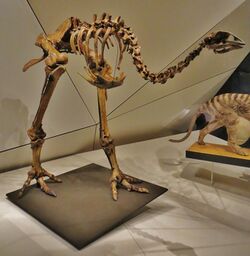Biology:Eastern moa
| Eastern moa Temporal range: Pleistocene-Holocene
| |
|---|---|

| |
| Skeleton in Musee des Confluences, Lyon | |
| Scientific classification | |
| Domain: | Eukaryota |
| Kingdom: | Animalia |
| Phylum: | Chordata |
| Class: | Aves |
| Infraclass: | Palaeognathae |
| Order: | †Dinornithiformes |
| Family: | †Emeidae |
| Genus: | †Emeus Reichenbach, 1852 |
| Species: | †E. crassus
|
| Binomial name | |
| †Emeus crassus | |
| Synonyms | |
|
List
| |
The eastern moa (Emeus crassus) is an extinct species of moa that was endemic to New Zealand.[2][3]
Taxonomy
When the first specimens were originally described by Richard Owen, they were placed within the genus Dinornis as three different species, but, was later split off into their own genus, Emeus.[4] E. crassus is currently the only species of Emeus, as the other two species, E. casuarinus and E. huttonii are now regarded as synonyms of E. crassus. It has been long suspected that the "species" described as Emeus huttonii and E. crassus were males and females, respectively, of a single species. This has been confirmed by analysis for sex-specific genetic markers of DNA extracted from bone material; the females of E. crassus were 15-25% larger than males.[5] This phenomenon — size dimorphism — is not uncommon amongst ratites, being also very pronounced in kiwis.
Description
Emeus was of average size, standing 1.5 to 1.8 metres (4.9–5.9 ft) tall. Like other moa, it had no vestigial wing bones, hair-like feathers (beige in this case), a long neck and large, powerful legs with very short, strong tarsi. It also had a sternum without a keel and a distinctive palate.[6] Its feet were exceptionally wide compared to other moas, making it a very slow creature. Soft parts of its body, such as tracheal rings (cartilage) or remnants of skin were found, as well as single bones and complete skeletons. As they neared the head, the feathers grew shorter, until they finally turned into coarse hair-like feathers; the head itself was probably bald.[7]
Range and habitat
Eastern moa lived only on the South Island, and lived in the lowlands (forests, grasslands, dunelands, and shrublands).[6] Human colonists (specifically the Māori, who called them "moa mōmona")[1] hunted Emeus into extinction with relative ease. Like all moa, it was gone by the year 1500.
References
- ↑ 1.0 1.1 "Emeus crassus. NZTCS". https://nztcs.org.nz/assessments/119037.
- ↑ Benes, Josef (1979). Prehistoric Animals and Plants. London, UK: Hamlyn. p. 192. ISBN 0-600-30341-1.
- ↑ Tennyson, Alan J. D. (2006). Extinct birds of New Zealand. Paul Martinson. Wellington, N.Z.: Te Papa Press. pp. 34. ISBN 978-0-909010-21-8. OCLC 80016906. https://www.worldcat.org/oclc/80016906.
- ↑ Owen, Richard (1846). "Description of Dinornis crassus". Proceedings of the Zoological Society of London 1846: 46.
- ↑ Huynen, Leon J.; Millar, Craig D.; Scofield, R. P.; Lambert, David M. (2003). "Nuclear DNA sequences detect species limits in ancient moa". Nature 425 (6954): 175–178. doi:10.1038/nature01838. PMID 12968179. Bibcode: 2003Natur.425..175H.(2003)
- ↑ 6.0 6.1 Davies, S. J. J. F. (2003). "Moas". in Hutchins, Michael. Grzimek's Animal Life Encyclopedia. 8 Birds I Tinamous and Ratites to Hoatzins (2 ed.). Farmington Hills, MI: Gale Group. pp. 95–98. ISBN 0-7876-5784-0.
- ↑ Rawlence, Nj; Wood, Jr; Scofield, Rp; Fraser, C; Tennyson, Ajd (2013). "Soft-tissue specimens from pre-European extinct birds of New Zealand". Journal of the Royal Society of New Zealand 43 (3): 154–181. doi:10.1080/03036758.2012.704878. Bibcode: 2013JRSNZ..43..154R.
External links
- Eastern Moa. Emeus crassus. by Paul Martinson. Artwork produced for the book Extinct Birds of New Zealand, by Alan Tennyson, Te Papa Press, Wellington, 2006
Wikidata ☰ Q1268926 entry
 |




